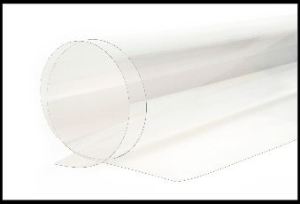May 29 2014
With smart materials being one of the fastest growing areas of materials technology, SABIC and Cima NanoTech, a Singapore and US-based company, have announced the joint development of a plastics industry first: a transparent conductive polycarbonate film that has the potential to revolutionize the materials used in consumer electronics, household goods, automotive, architecture and healthcare.
 SABIC LEXAN Polycarbonate Film
SABIC LEXAN Polycarbonate Film
The new material, designed to provide “next generation” functionality, has the potential to further enhance performance, enable new innovative applications and open doors for new product designs, Ernesto Occhiello, SABIC Executive Vice President, Technology and Innovation, explained. This could translate into faster response touch screens for consumer electronics, transparent “no-line” anti-fogging capabilities for automotive windows, better EMI shielding effectiveness for electronics, and transparent WiFi/Bluetooth antennas for mobile devices like smartphones, tablets, laptops and all-inone computers.
Aligned with SABIC’s focus to provide solutions that will solve industry challenges, SABIC engaged in a joint collaboration with Cima NanoTech in the latter half of 2013 to develop the promising new material, which will be available for customer trials later this year.
“Transparent conductive polycarbonate is a breakthrough material that customers in consumer electronics and other important industries have been seeking,” Matt Gray, Director of Marketing, Consumer Electronics for SABIC’s Innovative Plastics business, said. “Our work with Cima NanoTech is strategically aligned with our commitment to continuous innovation in areas of importance to our customers,” Gray noted.
The collaboration, leveraging both Cima NanoTech’s proprietary SANTE® nanoparticle technology and SABIC’s world-renowned LEXAN™ film, a polycarbonate material, has resulted in the development of a new series of transparent conductive materials that are ightweight with excellent transparency, outstanding conductivity and high flexibility. Cima NanoTech worked with SABIC’s world-class team of scientists to jointly develop materials that not only meet the requirements of existing industries, but also stretches the possibilities for exciting opportunities by breaking boundaries faced with current materials.
“We are very pleased to be working with SABIC to bring the key advantages of SANTE® nanoparticle technology forward into a number of diverse consumer and industrial markets,” Jon Brodd, Chief Executive Officer, Cima NanoTech, stated. SANTE technology, a patented self-assembling nanoparticle technology platform, stands alone in providing high transparency with ultra-low electrical resistance, which is ten times better than the incumbent indium tin oxide (ITO). “In addition to its ability to meet optical grade specifications for display and touch applications, SANTE® nanoparticle technology is also more cost effective as coating is performed via a wet coating, roll-to-roll process versus sheet-to-sheet,” Brodd said. The conductive SANTE network is also mechanically robust, thus allowing it to withstand flexing, stretching, torsion and tension for flexible applications. The substrate can also be thermoformed into various curved and 3D form factors.
Customers interested in sampling the new material are invited to e-mail SABIC at [email protected].